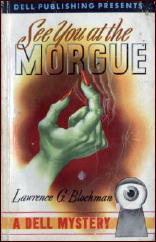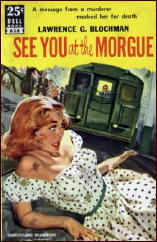Fri 11 Oct 2013
Reviewed by William F. Deeck: LAWRENCE G. BLOCHMAN – See You at the Morgue.
Posted by Steve under Reviews[3] Comments
William F. Deeck

LAWRENCE G. BLOCHMAN – See You at the Morgue. Duell Sloan & Pearce, hardcover, 1941; Dell #7, no date [1943]; Dell #638, paperback, no date [1952]. Both paperbacks are mapback editions.
Vivian Sanderson is marking time working as a “phantom secretary” — those who not only take phone messages but “give out price quotations, take accident reports at night for insurance companies, accept orders.” Sanderson gets an unusual message for her cousin, Penelope Dunne, suggesting that Dunne leave town because something is going to happen to her “white-haired boy.”
The next day, Dunne’s former boyfriend, a noted playboy, is found shot to death in her apartment. Sanderson, natural!y — where else would she be in a mystery? — is on the premises when the body is discovered by her boy-friend, who most unsatisfactorily tries to cover up her presence.

Sanderson is an intelligent, level-headed female for the most part. But the author feels it necessary to make her, in a term presently making the political rounds, a “useful idiot.” Blochman has her do things that she definitely ought not, such as receive a message from someone who may be the killer and then go dashing off to make the appointment suggested. This leads to her nearly getting run over in the subway.
The best of the book, and worth reading it for, is the police-procedural part, featuring Kenneth Kilkenny, Detective First Grade. Kilkenny is an interesting character and a good investigator. It’s a pity that Blochman didn’t devote more of the novel to Kilkenny and less to the damsel-in-distress-boyfriend-somewhat-to-the-rescue theme.
Bibliographic Note: Kenneth Kilenny made a second appearance in Death Walks in Marble Halls. Dell 10 Cent Edition #19, 1951. (First published in The American Magazine, September 1942.)
October 12th, 2013 at 12:55 am
At the Windy City Pulp convention a few months ago, I bought the original cover painting for Death Walks in Marble Halls. I don’t think I’ve ever seen original art from a Dell 10 cent paperback.
The cover painting was also reprinted in the New Yorker in the 1990’s to illustrate an article on true crime. I couldn’t pass it up since it shows a woman screaming in fear in a library full of books. Typical non-collector…
October 12th, 2013 at 4:13 pm
Great cover, and great film. Death Walks the Marble Halls is also the basis for John Larkin’s film Quiet Please, Murder!.
October 12th, 2013 at 4:56 pm
Speaking of covers, here we go:
I reviewed the movie way back here:
https://mysteryfile.com/blog/?p=1089